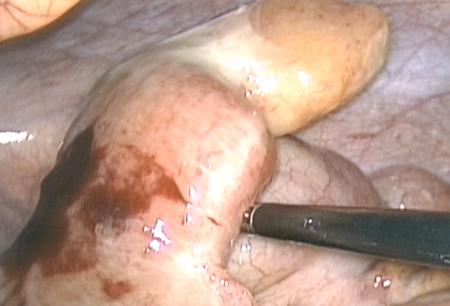History and exam
Key diagnostic factors
common
age <2 years
passage of bright red blood per rectum (haematochezia)
Along with obstruction, one of the two common presentations in both adults and children.[4] Classically, the bleeding is acute, episodic, and painless. Passage of dark red, maroon, or 'currant jelly' stools can be a symptom of intussusception, which is also associated with obstructive symptoms.
intractable constipation (obstipation)
Small bowel obstruction is a common presentation in both children and adults, and the obstipation can be a symptom of the intestinal obstruction.
Other diagnostic factors
common
male sex
Most patients with symptomatic or resected Meckel's diverticulum are male, but the male-to-female ratio may decrease with increasing age.[1][9][12] In one large database review in the US, the male-to-female ratio among children aged 1-17 years was 3.5:1, compared with 1.6:1 among older adults aged 65-84 years.[12]
nausea and vomiting
May be a symptom of intestinal obstruction. Small bowel obstruction is the most common presentation in children. Intussusception is one of the common mechanisms leading to bowel obstruction and may be associated with dark red, maroon, or 'currant jam' stools.
abdominal cramps
May be a symptom of intestinal obstruction.
lower abdominal pain
Meckel's diverticulitis is usually seen in older patients, accounting for 20% to 35% of symptomatic adult cases, and presents with abdominal pain in the periumbilical area that radiates to the right lower quadrant; often clinically indistinguishable from acute appendicitis.[18][19][Figure caption and citation for the preceding image starts]: Inflamed Meckel's diverticulumFrom the collection of Dr Ali Tavakkoli; used with permission [Citation ends].
diffuse abdominal tenderness
Meckel's diverticulitis or small bowel obstruction may progress to bowel perforation, especially in the setting of delayed diagnosis, and cause diffuse peritonitis.
uncommon
palpable abdominal mass
The free diverticulum can act as a lead point for an ileocolic or ileoileal intussusception.
Palpation of the abdomen usually reveals a slightly tender sausage-shaped mass, sometimes ill-defined.
Any mass is most often in the right upper abdomen, with its long axis cephalocaudal.
hypotension/tachycardia
Patients with gastrointestinal bleeding may be haemodynamically unstable.
Risk factors
weak
there are no known risk factors
There are no known risk factors for Meckel's diverticulum. Risk factors for the development of symptoms include male sex and age less than 2 years.
Use of this content is subject to our disclaimer